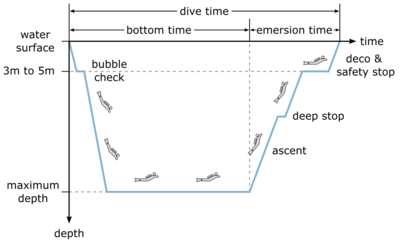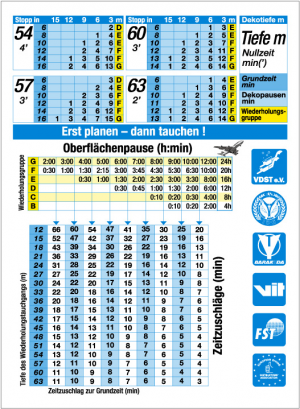Decompression calculation
The purpose of a decompression calculation is the monitoring of nitrogen saturation in the body of the diver. Its purpose is to plan a dive within its set limits like bottom and ascend time considering available air and air consumption, necessary decompression and/or safety stops. It is an essential part of the dive planning.
Although today's calculation is done almost exclusively by dive computers, the procedure presented here with a decompression table illustrates the underlying principles and concepts. It also gives you a feel for time limits especially no decompression limits if something goes wrong with your computer.
Contents
Basic knowledge for Open Water Diver* (OWD*)
Basic concepts

The following topics are essential for both, the decompression calculation with a decompression table as well as when using a dive computer:
- Dive time
The dive time is the total time spent underwater.
- Bottom time
This is defined as the elapsed time from starting the descent to starting the final ascent to the surface, excluding ascent and decompression time. I. e. the descent time plus the time staying at the depth (bottom).
- No-stop time or No-decompression-limit (NDL)
The no-stop time is the maximum bottom time you can spend in a defined depth without having to do a decompression stop. The no-stop time should not be exceeded in recreational diving. A dive that is within this limit is called a no-stop dive. If the no-stop time is exceeded, deco stops are mandatory and the dive is described as a decompression dive.
- Surface interval
The surface interval is the total time spent out of the water on the surface between two dives.
- Desaturation
Even after reaching the surface there is still an increased nitrogen saturation in the body, which is slowly reduced during the next 24 hours. If further dives (repetitive dives) are carried out during this periode of time, the residual saturation must be taken into account for the decompression calculation. The no-stop time is cut short by the time surcharge, or the time surcharge must be added to the bottom time. At the beginning of the repetitive dive, there is still such a high level of residual nitrogen in the body, as if you had already been diving for the length of the time surcharge in a predefined depth. Since this is a calculated time to account only for residual nitrogen, it is not included in the air consumption calculation.
- Ascent
The ascent is the movement towards the surface. The ascend may be interrupted by deep, deco and safety stops. The ascent rate may not exceed 10 m per minute, above 10 m of depth, 6 m per minute. Most modern dive computers will give you an audible and visual alarm when exceeding the maximum allowable ascend rate. As rough reference point you may not overtake the smallest bubbles of your exhaled air.
- Emersion
The emersion refers to the entire ascent to the surface including all necessary deep, deco and safety stops.
- Safety stop
A safety stop should be performed independently of any necessary deep and deco stops in order to reduce your nitrogen saturation. The depth should be between 3 m and 5 m for 3 minutes to 5 minutes. In a decompression dive, the mandatory decompression time at 3 meters is extended by the time of the safety stop.
- Deco stop
If the bottom time exceeds the no-stop time, the ascent must be interrupted by deco stops in order to reduce the nitrogen saturation in the body below the critical value to prevent a decompression sickness. The depth and duration of the deco stops depend on the depth, bottom time of the dive and residual nitrogen saturation of previous dives. The necessary stops must be determined by means of a decompression table or with the aid of a dive computer.
- Deep stop
It is recommended that you also take a deep stop at half maximum depth for about 2 minutes to 3 minutes when ascending. Although this extends the dive time and, if necessary, the deco stops, the amount of microbubbles in the blood is greatly reduced, as the nitrogen-supersaturated blood is passed through the lungs several times during this time and can partly desaturate.
- Bubble check
The bubble check is a control stop at the descent between 3 m and 5 m to check the diving equipment for air leaks.
Decompression table
The purpose of a decompression or dive table is to determine the no-stop time and, if necessary, the mandatory deco stops based on maximum depth, bottom time and residual nitrogen saturation.
There is a variety of decompression tables on the market. We are using the dive table DECO 2000. It is valid from sea level to a height of 700 m. When diving in mountain lakes over 700 m of height, special altitude dive tables are to be used. Altitude dive tables take into account the lower atmospheric pressure at mountain lakes.
A decompression table always assumes a rectangular dive profile. This means for the calculation it is assumed that the total bottom time was spent at maximum depth during the dive.
Structure
The front is divided into various tables. The first column shows the maximum diving depth and below that the no-stop time for this depth. This is only valid for a dive without residual nitrogen saturation. The second column contains the dived bottom time. The following columns indicate the length of the deco stops at the corresponding depths. The last column provides information about the nitrogen saturation at the end of the dive (repeating group). White lines are no-decompression dives, dark lines are decompression dives.
On the back, the tables of the front are continued to greater depths. The lower part serves to determine the residual nitrogen saturation after a defined surface interval and the time surchargetime which has to be added to the bottom time of the next dive for the decompression calculation. The last column marked with an aircraft symbol indicates the no-fly time. This period of time must be between the last dive and a flight, because in the aircraft cabin, the ambient pressure is lowered to about 0.75 bar. The no-fly time also applies to trips over mountain passes.
Usage
The usage of the decompression table is illustrated below with an example:
- No-stop time (NDL): The first dive (without residual nitrogen saturation) takes you to a maximum depth of 19 m. Since this depth level is not present in the DECO 2000, you use the next lower level for safety reasons. The next lower depth in the table is 21 m on the front. The no-stop time is 31 minutes.
- Deco stops: Your bottom time was 25 minutes. Since this value is not present in the column with the bottom times, again for safety you use the next larger existing value, e. g. the line with 26 minutes. There are no deco stop entries in this line, which makes your dive a no-stop dive and you should only do safety stop during the ascent. You also recognize that your bottom time of 25 minutes was less than the no-stop time of 31 minutes.
- Repetitive group: At the end of the line you will find the repetitive group for the dive: E which accounts for the actual nitrogen saturation at the end of the dive.
- Time surcharge: After a surface interval of 1 hour and 45 minutes, you perform another dive to a depth of 18 meters. On the back of the DECO 2000 you now use the surface interval table. Follow the line that begins with your repetitive group E to the right until the time interval matching your pause between the dives. In this example between 1 hour 30 minutes and 2 hours. Now follow the arrow to the column in the next table. The field at the intersection with the line of depth for your repetitive dive will give you a time surcharge of 26 minutes.
- Deco stops and repetitive groups for repetitive dive: The bottom time of the repetitive dive is 30 minutes. You have to add the time surcharge of 26 minutes. Hence, you have to calculate on a bottom time of 56 minutes. The next higher time step of the table for 18 m at the front is 65 minutes. In this line, you read a deco stop of 8 minutes at a depth of 3 meters and repetitive group G.
- No-fly time: If you follow line G to the right in the surface interval table on the back, your no-fly time after the two dives is 24 hours.
Safety instructions
The decompression calculation – both with decompression table as well as with the help of a dive computer – is based on statistics and model calculations and cannot take all eventualities into account. In general: Minimize risks and dive conservative! In addition to the requirements regarding stops and safe ascent rate, this also includes the following:
- On no-stop dives stay away from the limits. Start your ascent well before the no-decompression limit is reached.
- Maintain at least a 24-hour surface interval between the last dive and a flight or crossing mountain pass.
- Do not do a yo-yo dive: During continues ascending and descending, tissues are permanently desaturated and again saturated. The actual saturation state can only be reproduced inaccurately by model calculations and tables, and the decompression instructions can therefore be inaccurate.
- Keep at least a 2-hour surface interval between dives to minimize residual nitrogen saturation before the repetitive dive.
- No sport before and after the dive: The increased blood flow increases the risk of developing a decompression sickness due to microbubbles.
- Avoid dehydration by adequate fluid intake: A too low fluid balance slows down the desaturation and increases the risk of DCS.
- No alcohol, no drugs, no smoking: In addition to the intoxicating and unhealthy effect of all Medication, intoxicants and stimulants change the blood flow through various tissues and change the saturation and desaturation behavior.
- Consider your own personal risks such as overweight or PFO.






